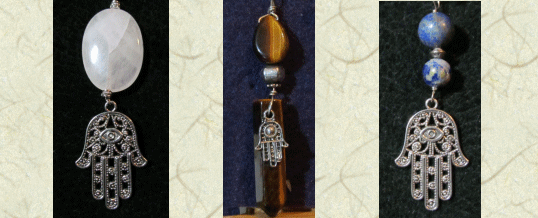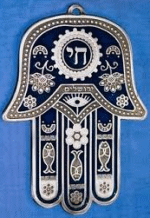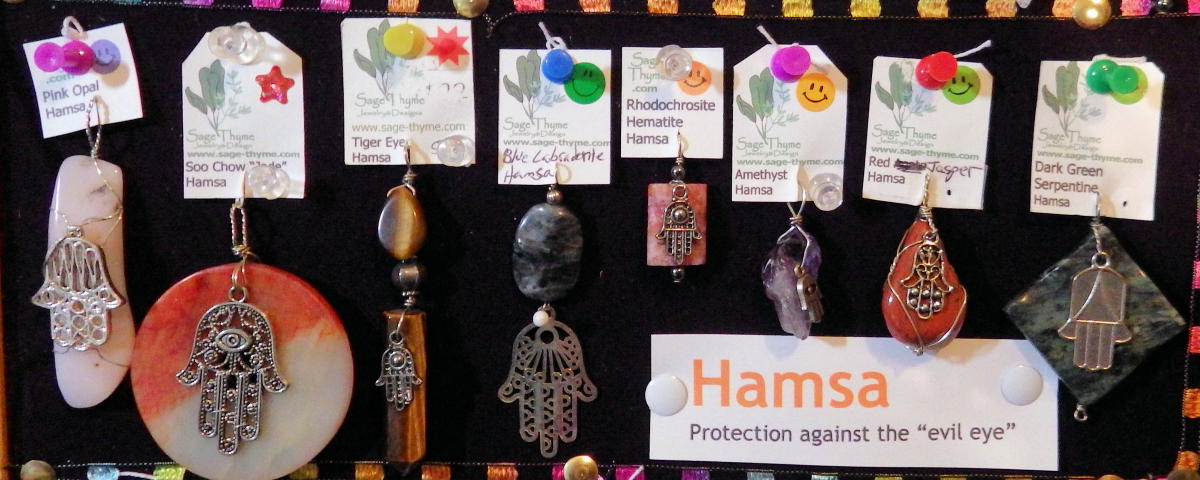The Ancient Hamsa

What is a Hamsa?
The hamsa, an ancient Middle Eastern amulet symbolizing the Hand of God, is one of the most ancient amulets used in modern culture. Archeological digs in the Middle East provide evidence that the hamsa pre-dates Judaism and Islam, originating with the Phoenicians. The hamsa hand has always been associated with a female entity, such as an ancient Middle Eastern goddess, offering protection from evil and misfortune. Another association is to Tanit, the Moon goddess, who was one of the patron goddesses of Carthage. Tanit was associated to fertility and war.
Where Does the Hamsa Get its Name?
The word “hamsa” or “hamesh”, as it is also known (Hebrew), means five. In addition to the five digits on the hamsa hand matching the human hand, the number five has other symbolic meanings in both the Jewish and Islamic traditions.
Five, for Jews, represents the five books of the Torah, as well as symbolizing the fifth letter of the Hebrew alphabet, “Heh”, which represents one of God’s holy names. The Jewish hamsa hand also symbolizes the Hand of God. Many Jews believe that the five fingers of the hamsa hand remind its wearer to use all of their five senses to praise God. In keeping with the Goddess theme, the hamsa pendant also symbolizes the Hand of Miriam, the sister of Moses and Aaron.
In the Islamic faith, the hamsa hand symbolizes The Hand of Fatima, daughter of the Prophet Mohammed. For Sunnis, five represents the Five Pillars of Islam, and for Shi’ites, the Five People of the Cloak.
Symbolism of the Hamsa
 The shape of the Hamsa hand, unlike the normal human hand, is symmetrical, with thumbs on both sides. Sometimes it is also adorned with an eye symbol, is a powerful talisman against the evil eye. The evil eye is a certain “look” that can cause bad luck for the person at whom it is directed. Other symbols that can appear on the hamsa include a fish, a Star of David, and certain Hebrew words. Fish are thought to be immune to the evil eye and are also symbols of good luck. Going along with the luck theme, “mazel” – meaning “luck” in Hebrew – is a word that is sometimes inscribed on the amulet. In addition to averting the gaze of the evil eye, this talisman brings its wearer or owner happiness, luck, health, and good fortune.
The shape of the Hamsa hand, unlike the normal human hand, is symmetrical, with thumbs on both sides. Sometimes it is also adorned with an eye symbol, is a powerful talisman against the evil eye. The evil eye is a certain “look” that can cause bad luck for the person at whom it is directed. Other symbols that can appear on the hamsa include a fish, a Star of David, and certain Hebrew words. Fish are thought to be immune to the evil eye and are also symbols of good luck. Going along with the luck theme, “mazel” – meaning “luck” in Hebrew – is a word that is sometimes inscribed on the amulet. In addition to averting the gaze of the evil eye, this talisman brings its wearer or owner happiness, luck, health, and good fortune.
It has been said that when the Hamsa points to the ground, it draws female energies and good fortune. When the Hasma points to the sky, it draws male energies, keeps out evil eye, and brings personal protection.
Gallery

